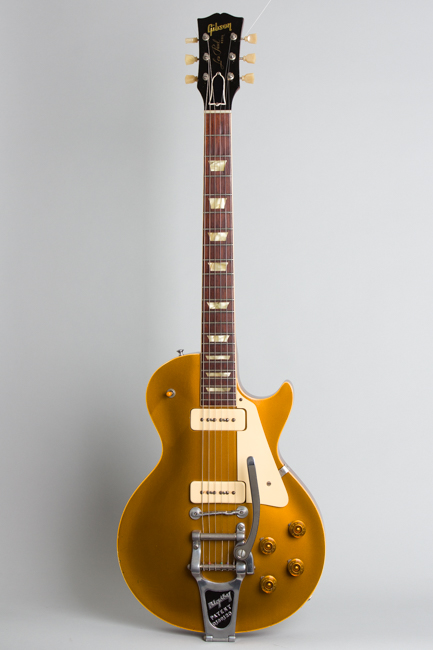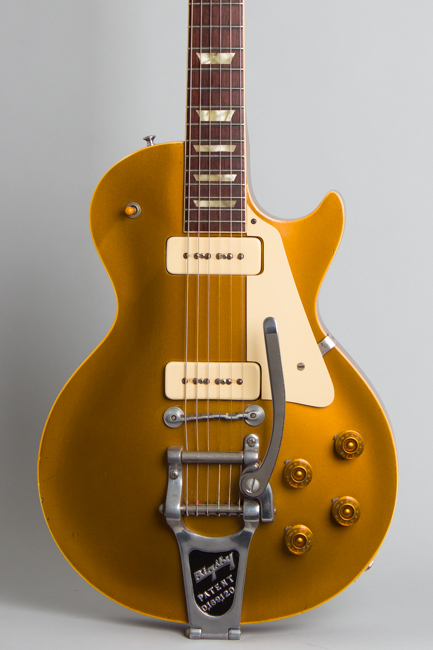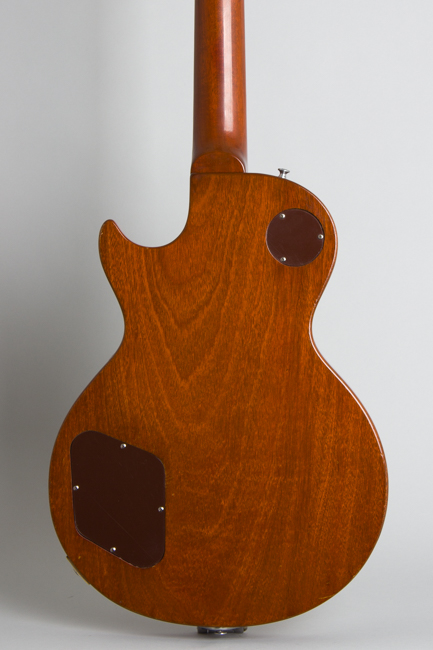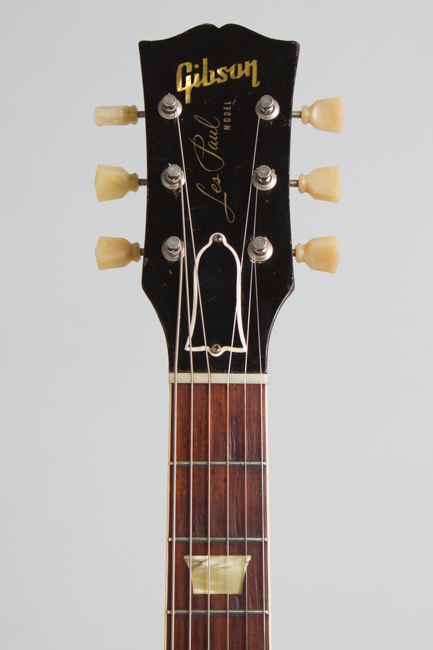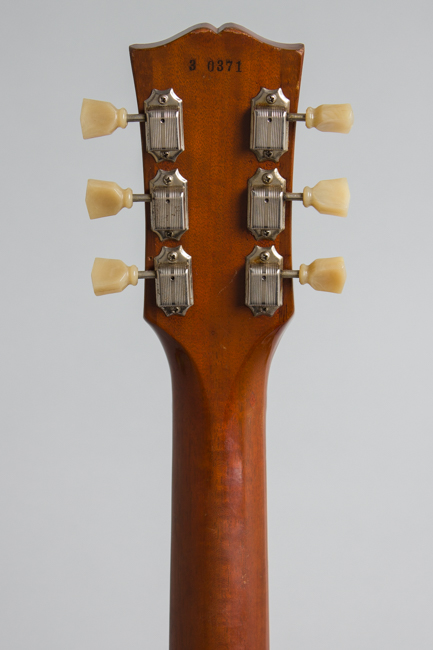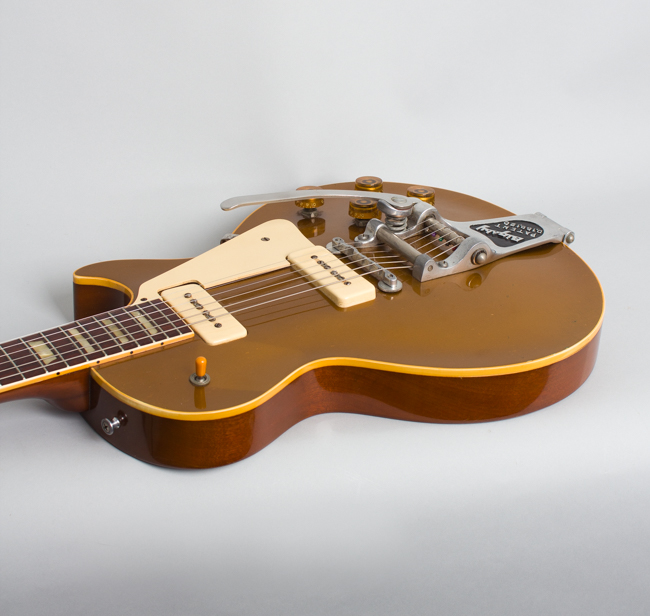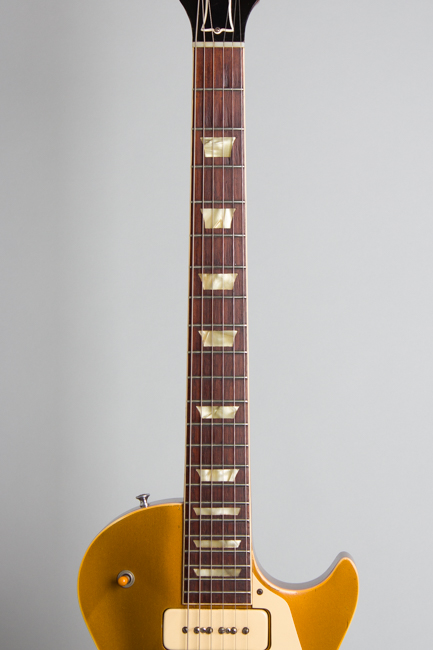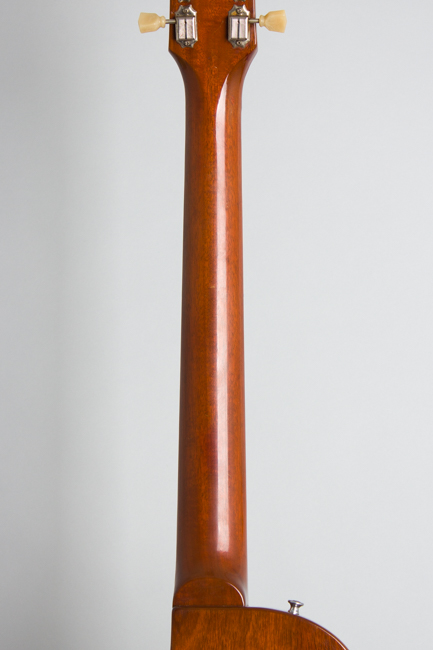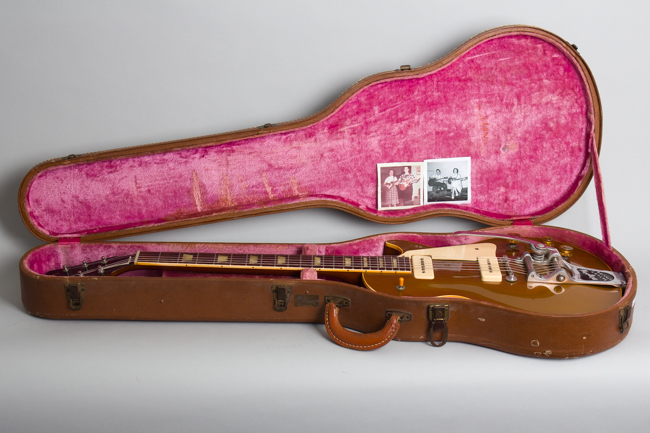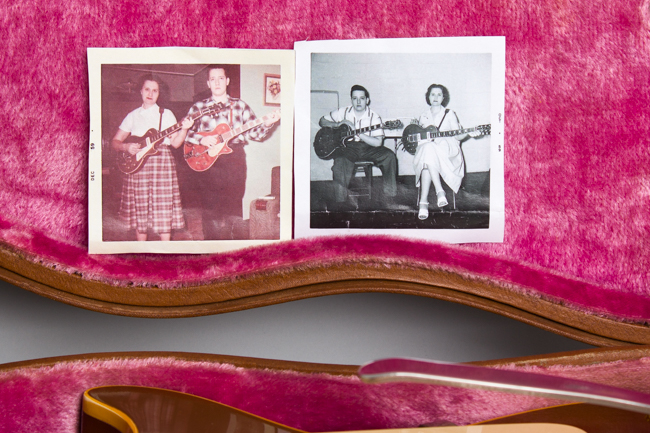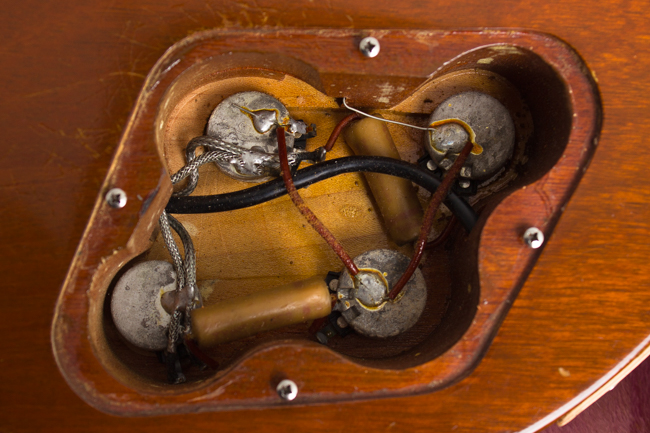Gibson Les Paul Model Solid Body Electric Guitar (1953)
This item has been sold.
Item # 12649
Prices subject to change without notice.
Gibson Les Paul Model Model Solid Body Electric Guitar (1953), made in Kalamazoo, Michigan, serial # 3-0371, gold lacquer top, natural back and sides finish, mahogany body with maple cap, mahogany neck with rosewood fingerboard, original brown hard shell case.
This is a very cool example of one of the most important guitars in Gibson's history -- the original 1952-3 Les Paul Model, the company's first solidbody Spanish electric. It dates to the beginning of 1953, the second year of production and has one old -- and very useful -- modification: a later 1950s Bigsby vibrato tailpiece and bridge added. As the first iteration of this classic solid-body fitted the "Les Paul" trapeze tailpiece with the strings wrapped UNDER the bar, the Bigsby bridge makes this a MUCH more playable guitar than it was originally while still retaining the vintage character. The Bigsby unit dates to around 1957-8 and looks to have been installed when new; there are pictures of the original young lady owner included showing it in place "back in the day". At the same time the guitar appears to have gotten a light clear finish overspray everywhere but the headstock face.
The other features of this early 1953 model are classic Les Paul appointments including the big chunky round-backed '53 neck with a bound rosewood fingerboard with pearloid trapezoid inlays, twin P-90 pickups under cream plastic covers with center-mount screws and Kluson Deluxe tuners with keystone-shaped buttons. In an idiosyncratic touch, the pearl Gibson logo is set lower down on the headstock than later '50s models. Gibson had only recently figured out how they wanted to serialize these new solidbody instruments; this one has one of the first ink-stamped date coded numbers on the back of the headstock.
While these early Les Pauls are generally not the favorites of players due to the eccentric bridge design this one is a far more playable guitar than when fitted with the original under-bar bridge/tailpiece. The Bigsby works well and the aluminum bridge allows palm muting where the original under-bar tailpiece did not. At just under 9 Lbs. even with the Bigsby fitted this is a relatively handy guitar, and balances well.
The first solid-bodies with the class of a Gibson, these guitars convinced many players to lay down their electrified arch-tops and enter the new world of higher volume. Later developments of the Les Paul line included the upscale Custom, down-market Special and Junior and reworked Standard in gold and sunburst, but this is the guitar that started it all. Many players at the time including Sister Rosetta Tharpe, John Lee Hooker and Muddy Waters made great use of them when new, regardless of the bridge design. This guitar is similar to the '53 that originally equipped Carl Perkins in his sun records days, also fitted with the Bigsby tailpiece. It has been used but not been too heavily played and is a fantastic piece of Gibson history with a killer vibe.
Overall length is 39 in. (99.1 cm.), 13 in. (33 cm.) wide at lower bout, and 1 15/16 in. (4.9 cm.) in depth, measured at side of rim. Scale length is 24 3/4 in. (629 mm.). Width of nut is 1 11/16 in. (43 mm.)., 8.94 lbs.
This 70+ year old Les Paul shows some fairly light play wear but no major damage or repair. It remains all original except for the work done many decades ago: The substitution of the Bigsby unit for the original trapeze tailpiece and a light clear lacquer overspray over the body and neck; everywhere BUT the headstock face. This was not too heavily done and is fairly subtle; it was probably added when the instrument was a few years old to "shine it up" a bit, something not uncommon in the 1950s. There is subsequent light wear with minor dings, chips and dents, some over and a few under the clearcoat.
All hardware is original except the Bigsby tailpiece and bridge, which are just a few years later. The Bigsby bridge posts were mounted directly to the top, like the subsequent Tune-O-matic setup on later Les Pauls; everything is completely solid and works well. The external hardware shows light general wear. Internally all wiring is original and unaltered, with the original large wax capacitors still functional. A hard foam riser was added under the bridge pickup to equalize the output with the neck unit.
The original narrow frets are still intact; they show some minor wear in the lower positions where there is some light divoting to the rosewood fingerboard. The guitar is still very playable with a really superb sound. When all-time classic solidbodies are discussed, these first gold-top 1952-3 Les Pauls are often discounted due to the bridge design, but this one has solved that problem in a totally vintage correct way and is a truly excellent instrument.
This gold top beauty is housed in the original period Lifton brown case that is lightly worn and fully intact. In the pocket are copies of 1959-dated photos of a young lady playing this guitar alongside her companion, who has a Gretsch Chet Atkins solidbody. We hope they made beautiful music together! This guitar and case are very well preserved but still just from the vibe it gives off it must have seen some glorious times. Overall Excellent - Condition.
This is a very cool example of one of the most important guitars in Gibson's history -- the original 1952-3 Les Paul Model, the company's first solidbody Spanish electric. It dates to the beginning of 1953, the second year of production and has one old -- and very useful -- modification: a later 1950s Bigsby vibrato tailpiece and bridge added. As the first iteration of this classic solid-body fitted the "Les Paul" trapeze tailpiece with the strings wrapped UNDER the bar, the Bigsby bridge makes this a MUCH more playable guitar than it was originally while still retaining the vintage character. The Bigsby unit dates to around 1957-8 and looks to have been installed when new; there are pictures of the original young lady owner included showing it in place "back in the day". At the same time the guitar appears to have gotten a light clear finish overspray everywhere but the headstock face.
The other features of this early 1953 model are classic Les Paul appointments including the big chunky round-backed '53 neck with a bound rosewood fingerboard with pearloid trapezoid inlays, twin P-90 pickups under cream plastic covers with center-mount screws and Kluson Deluxe tuners with keystone-shaped buttons. In an idiosyncratic touch, the pearl Gibson logo is set lower down on the headstock than later '50s models. Gibson had only recently figured out how they wanted to serialize these new solidbody instruments; this one has one of the first ink-stamped date coded numbers on the back of the headstock.
While these early Les Pauls are generally not the favorites of players due to the eccentric bridge design this one is a far more playable guitar than when fitted with the original under-bar bridge/tailpiece. The Bigsby works well and the aluminum bridge allows palm muting where the original under-bar tailpiece did not. At just under 9 Lbs. even with the Bigsby fitted this is a relatively handy guitar, and balances well.
The first solid-bodies with the class of a Gibson, these guitars convinced many players to lay down their electrified arch-tops and enter the new world of higher volume. Later developments of the Les Paul line included the upscale Custom, down-market Special and Junior and reworked Standard in gold and sunburst, but this is the guitar that started it all. Many players at the time including Sister Rosetta Tharpe, John Lee Hooker and Muddy Waters made great use of them when new, regardless of the bridge design. This guitar is similar to the '53 that originally equipped Carl Perkins in his sun records days, also fitted with the Bigsby tailpiece. It has been used but not been too heavily played and is a fantastic piece of Gibson history with a killer vibe.
Overall length is 39 in. (99.1 cm.), 13 in. (33 cm.) wide at lower bout, and 1 15/16 in. (4.9 cm.) in depth, measured at side of rim. Scale length is 24 3/4 in. (629 mm.). Width of nut is 1 11/16 in. (43 mm.)., 8.94 lbs.
This 70+ year old Les Paul shows some fairly light play wear but no major damage or repair. It remains all original except for the work done many decades ago: The substitution of the Bigsby unit for the original trapeze tailpiece and a light clear lacquer overspray over the body and neck; everywhere BUT the headstock face. This was not too heavily done and is fairly subtle; it was probably added when the instrument was a few years old to "shine it up" a bit, something not uncommon in the 1950s. There is subsequent light wear with minor dings, chips and dents, some over and a few under the clearcoat.
All hardware is original except the Bigsby tailpiece and bridge, which are just a few years later. The Bigsby bridge posts were mounted directly to the top, like the subsequent Tune-O-matic setup on later Les Pauls; everything is completely solid and works well. The external hardware shows light general wear. Internally all wiring is original and unaltered, with the original large wax capacitors still functional. A hard foam riser was added under the bridge pickup to equalize the output with the neck unit.
The original narrow frets are still intact; they show some minor wear in the lower positions where there is some light divoting to the rosewood fingerboard. The guitar is still very playable with a really superb sound. When all-time classic solidbodies are discussed, these first gold-top 1952-3 Les Pauls are often discounted due to the bridge design, but this one has solved that problem in a totally vintage correct way and is a truly excellent instrument.
This gold top beauty is housed in the original period Lifton brown case that is lightly worn and fully intact. In the pocket are copies of 1959-dated photos of a young lady playing this guitar alongside her companion, who has a Gretsch Chet Atkins solidbody. We hope they made beautiful music together! This guitar and case are very well preserved but still just from the vibe it gives off it must have seen some glorious times. Overall Excellent - Condition.
